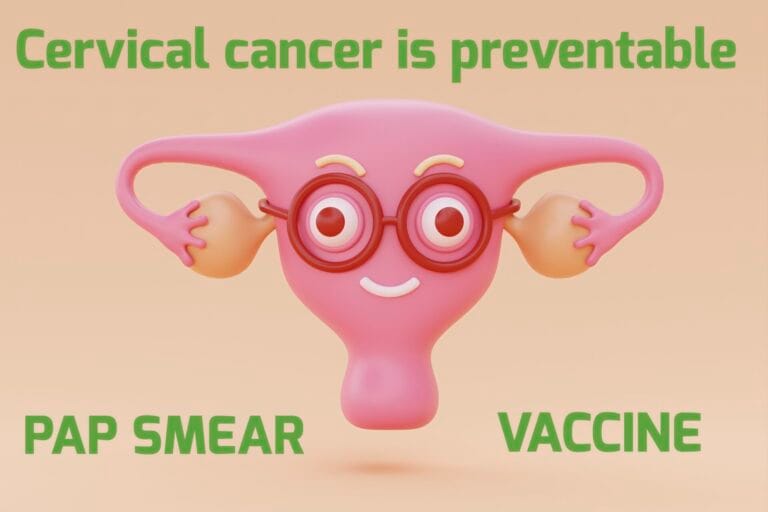Cervical cancer is the fourth most common cancer in women and is one of the most common preventable causes of morbidity and mortality in women. It is caused by a virus called Human Papillomavirus (HPV). The preventable nature of this cancer makes it unique among cancers. Let us first understand what exactly cervical cancer is, how it presents, how women get infected, and finally how to prevent it.
Table of Contents
What is Cervical Cancer?
Cervical Cancer is the cancer of the cells of the cervix. The cervix is the narrow, lower part of the uterus which is in contact with the vagina and is also called the mouth of the uterus. It is typically a disease of sexually active women of the reproductive age group and is uncommonly seen in young girls.
The disease is caused by a virus called Human Papillomavirus (HPV), which is transmitted by intimate sexual contact. All forms of sexual contact, whether penetrative or nonpenetrative can spread the virus. Most HPV infections remain asymptomatic and resolve spontaneously as the body’s immune system fights it back and removes it from the body.
When the body is unable to fight the HPV infection and it stays in the body for prolonged periods (in years), it starts causing abnormal changes in the cells of the cervix. These changes are called Dysplastic changes. These changes are precancerous and can develop into cervical cancer over 10-20 years.
Cervical cancer burden – factsheet
- Fourth most common cancer in women worldwide.
- Second most common cancer in women aged 15-44 years in India.
- Second most common cause of cancer-related deaths in women in India, which accounts for about one-fourth of cervical cancer-related deaths in the world.
The incidence of cervical cancer and cancer-related mortality in women is much higher in underdeveloped and developing countries due to inadequate cervical vaccination coverage, inadequate coverage of PAP smear testing, and inadequate treatment facilities.
Causes and risk factors for Cervical cancer
- Human Papillomavirus (HPV) infection: As discussed above, HPV is the causative agent of cervical cancer. However, it is pertinent to note that not all HPV infections cause cervical cancer. Persistent or prolonged infection (over years) with high-risk types of HPV (like 16,18) is positively linked to development of cervical cancer.
- Sexual behavior: Having more sexual partners and the early onset of sexual activity (<18 years) increase your risk of acquiring HPV and, consequently, the possibility of cervical cancer.
- Smoking: Smoking increases your risk of developing cervical cancer.
- HIV infection: HIV lowers immunity and the body is unable to fight the HPV infection. This causes HPV to persist in the body and increases the chances of cervical cancer.
- Weak immune system: Low immunity due to any cause (malnutrition, systemic diseases like SLE, MS or intake of immunosuppressive drugs or steroids, etc), causes persistent HPV infection and higher chances of cervical cancer.
- Sexually transmitted infections (STIs): Presence of other STIs like Chlamydia, Gonorrhoea, Syphilis, HIV, etc. indicate unhealthy and careless sexual behavior. Such patients are more likely to acquire HPV as well, thereby becoming more prone to cervical cancer.
- Oral contraceptive pills: Long-term intake of hormonal oral contraceptive pills may be linked to increased risk of cervical cancer.
- Positive family history: There is an increased risk of cervical cancer in women who have a history of first-degree relatives with cervical cancer.
- Socioeconomic status: It is seen that women in low and middle-income countries or low and middle-income families are more prone to the development of cervical cancer due to inadequate access to screening tests (PAP smear, HPV DNA), cervical cancer vaccination or treatment facilities.
- Diethylstilbestrol (DES): The intake of a drug called diethylstilbestrol is linked to the development of cervical cancer. This drug is not used nowadays, but was used till the 1970s to prevent miscarriage.
What are the symptoms of cervical cancer?
Any sudden onset, unexpected bleeding in a woman of reproductive age group, can be a symptom of cervical cancer. Following are the common symptoms of cervical cancer:
- Vaginal bleeding after sexual intercourse
- Bleeding in between periods (intermenstrual bleeding)
- Bleeding after menopause (Postmenopausal bleeding)
- Painful sexual intercourse (dyspareunia)
- Painful urination (dysuria)
- Persistent pelvic pain
- Abnormal or heavy, foul smelling vaginal discharge
- Blood-tinged vaginal discharge during the non-menstrual days
These symptoms are not specific to cervical cancer and may also be caused by other diseases like pelvic infections or inflammatory diseases. Please visit your healthcare provider in case of any such symptoms.
How does Cervical cancer develop?
- HPV infection is a very common sexually transmitted infection among sexually active adults. In fact, it is so common that every adult is likely to have HPV at some point in their life time.
- However, most HPV infections are taken care of by your body’s immune system.
- But sometimes, the body’s defense system is unable to fight the infection and it stays in the body.
- This persistent infection, especially by certain high-risk varieties of HPV (like 16,18), causes abnormal changes in the cells of the cervix. This takes many years.
- These abnormal changes are precancerous and can develop into cervical cancer in 10-20 years.
So the bottom line is that cervical cancer is a very slowly developing cancer and takes 15-20 years to develop. This highlights the importance of cervical cancer vaccination and regular screening tests like PAP smear testing or HPV DNA to detect abnormal changes at an early stage so that cervical cancer can be prevented.
Can we prevent cervical cancer?
Yes, cervical cancer is preventable with a few simple precautions, and certain life style modifications:
- Regular Cervical cancer screening: Cervical cancer is a slowly developing cancer. It takes many years for precancerous changes to develop and then further many years for the precancerous changes to develop into cancer. Regular screening tests like PAP Smear (see PAP Smear test) are recommended for all women, starting at the age of 21 years and repeated every three years. With these tests, cervical cancer can be identified at it’s precancerous stage or at an early stage of cancer. These stages are much easier to manage and the development of cervical cancer can be prevented by treating at an early stage.
- Cervical cancer vaccination: Cervical cancer vaccine is an effective method to reduce the risk of developing cervical cancer. All women below the age of 45 years should receive the vaccine. Contact your healthcare provider to receive your vaccine if you have not received it till now.
- Early treatment: Early detection and treatment of precancerous changes is the key to preventing the development of full-blown cervical cancer.
- Lifestyle changes: Quit smoking and reduce the number of sexual partners. A strictly monogamous relationship is ideal and prevents many more sexually transmitted infections, in addition to preventing HPV and cervical cancer.
- Diet: A good, nutritious, and balanced diet boosts your immunity and gives it strength to fight back.
- Prevention of STIs: If you are not planning a pregnancy, use barrier methods like condoms during intercourse. The use of barrier methods is an excellent contraceptive choice and is unique as it is the only method that prevents transmission of sexually transmitted infections, along with providing contraception. (see Barrier methods of contraception)
What is cervical cancer vaccine?
Cervical cancer is one of the very few cancers that are vaccine-preventable. Nowadays, effective vaccination against cervical cancer is available. There are many different brands of vaccines available, with slight differences in the HPV strains covered by them. However, most of the vaccines cover strains 16 and 18, which are the main culprits for the development of cervical cancer.
The age group of 9-14 years is the ideal age group for receiving the cervical cancer vaccine, although all women up to the age of 45 years can receive the vaccine. The vaccine may be administered in two or three doses, depending on the age. Please contact your healthcare provider for planning your cervical cancer vaccination.
Which factors affect the treatment of cervical cancer?
The treatment of cervical cancer depends on many factors like:
- Type of cancer: Cervical cancer is of two types – squamous cell carcinoma and adenocarcinoma. About 90% cases of carvical cancers are squamous cell carcinomas.
- Stage of cancer at the time of diagnosis: Cervical cancer is classified into 4 stages from stage 1 to stage 4, depending on the extent of the spread of cancer. Stage 1 is limited to the cervix only and stage 4 is the most advanced form of cancer with spread to other body parts.
- Other factors: like age of the patient, general health, and associated medical conditions may limit certain choices of treatment.
What is the treatment of cervical cancer?
There are many treatment options for cervical cancer. As indicated above, the exact choice of treatment modality to be used in a particular patient depends on many factors and is best decided by the healthcare provider. The various treatment choices include:
- Surgery
- Chemotherapy
- Radiation therapy
- Immunotherapy
Carry home message
- Cervical cancer is caused by a persistent and prolonged infection with certain high-risk types of Human Papillomavirus (HPV), particularly 16 and 18, which cause more than 70% of the cases.
- Cervical cancer can be detected when it is precancerous or at an early stage with regular screening tests like PAP smear and HPV DNA. Early detection and management of the precancerous stage can prevent cervical cancer from developing. Similarly, the detection of cervical cancer at an early stage carries a very good prognosis.
- Cervical cancer is one of the rare vaccine-preventable cancers. The cervical cancer vaccine is safe, effective, and easily available. All girls above the age of 9 years should receive the vaccine and can be administered to women up to the age of 45 years.
- Certain lifestyle changes like limiting the number of sexual partners, using barrier methods of contraception, quitting smoking, and taking a good nutritious diet, goa long way in preventing cervical cancer.

For more such interesting information on women's health, kindly visit our website Expert Gynae Care and our YouTube channel @drnidhigarg
To consult Dr. Nidhi Garg, please visit us at Kamal Hospital, Doaba Chowk, Jalandhar-144004 or Visit our website kamal Hospital jalandhar or Expert Gynae Care



1 thought on “Cervical cancer -Virus vs Vaccine”